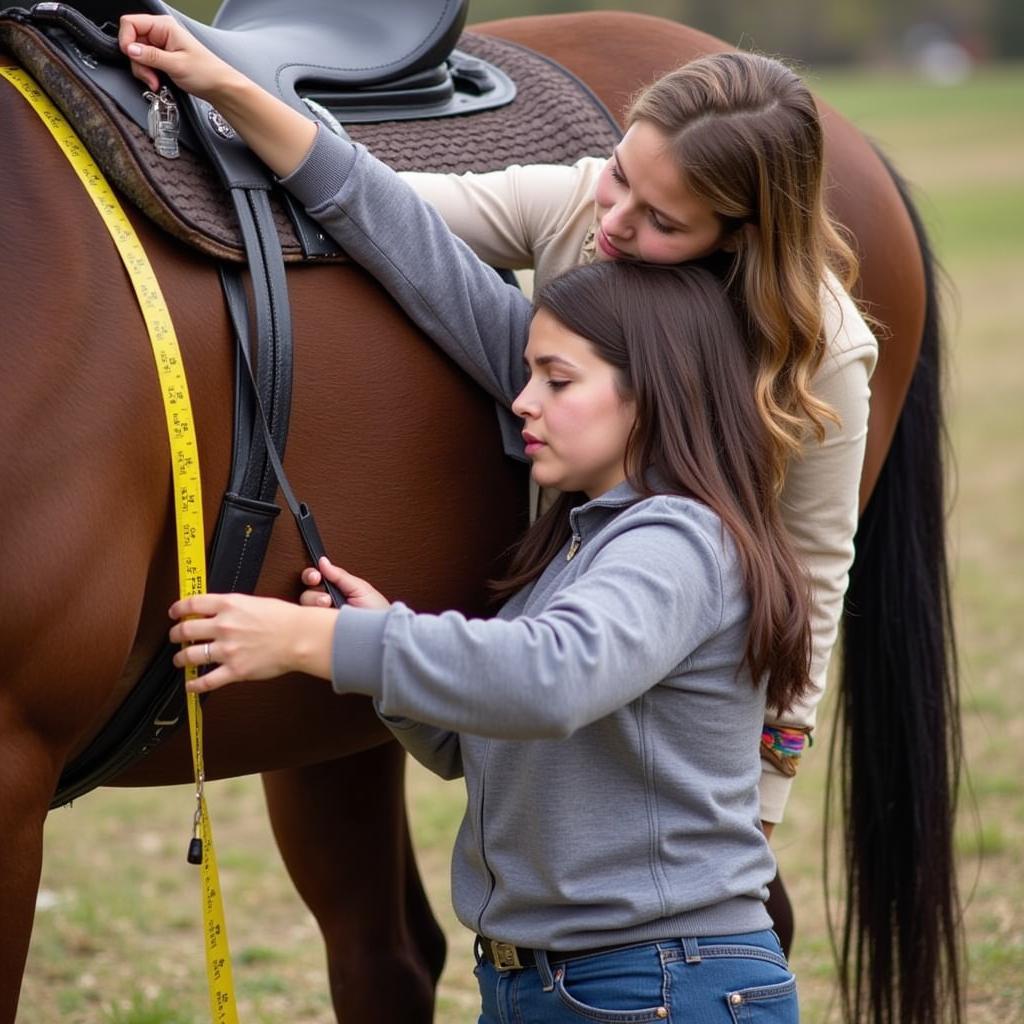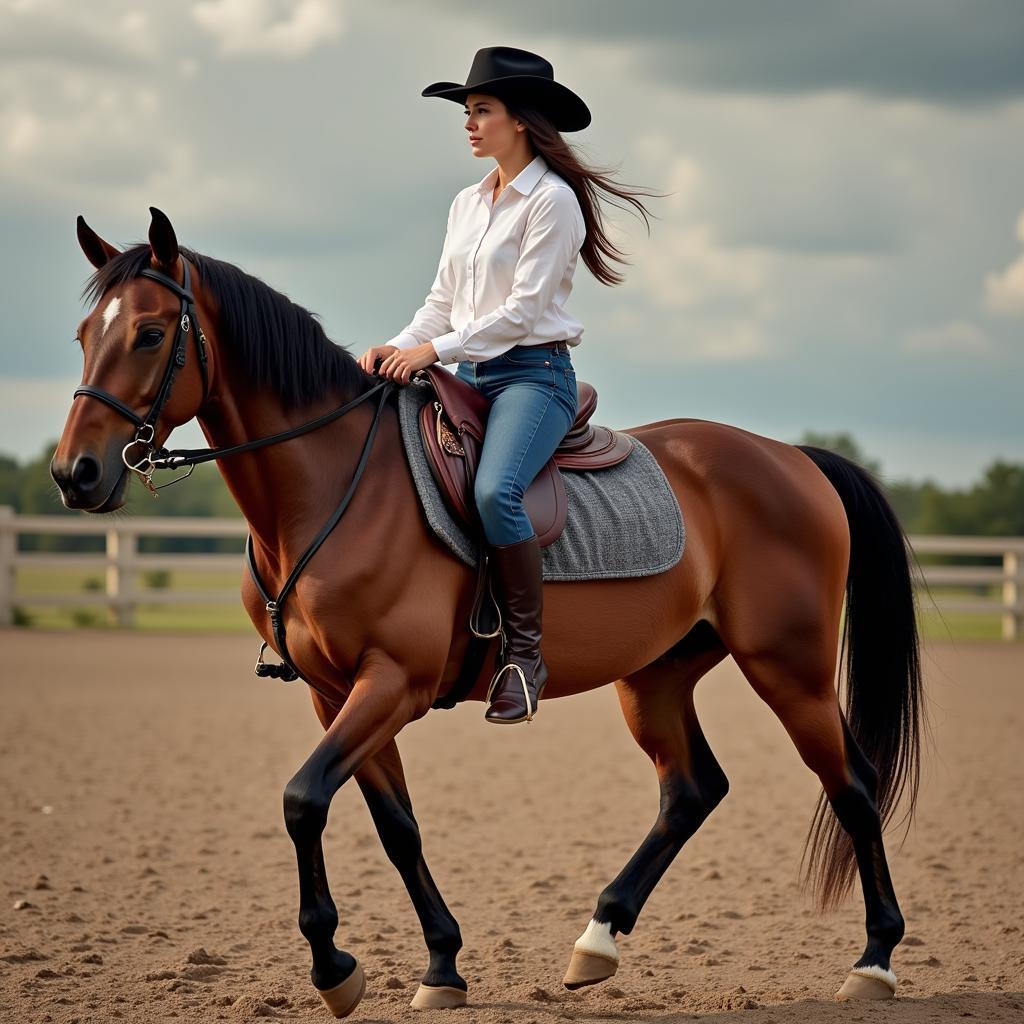Finding the perfect saddle for your equine partner is crucial for both their comfort and performance. An ill-fitting saddle can lead to pain, sores, and even behavioral issues. Knowing how to measure a horse for a saddle correctly is the first step in ensuring a proper fit.
Understanding Saddle Fit
Before you break out the measuring tape, it’s essential to understand the basics of saddle fit. A well-fitting saddle distributes the rider’s weight evenly across the horse’s back, avoiding pressure points on the withers, spine, or loin. It should allow for freedom of movement and not interfere with the horse’s natural gait.
Tools for the Job
To measure your horse for a saddle accurately, you’ll need a few simple tools:
- Flexible Measuring Tape: A flexible tape measure, preferably made of cloth or soft vinyl, will be your best bet.
- String and Yardstick/Meter Stick: This combination can be used as an alternative to a flexible tape measure.
- Pen and Paper: Keep track of your measurements!
- A Helper (Optional): An extra set of hands can be invaluable, especially when measuring for saddle width.
 Measuring a Horse for Saddle Fit
Measuring a Horse for Saddle Fit
Taking the Measurements
There are several key measurements you’ll need to take to determine the correct saddle size for your horse:
1. Wither Height and Back Length
- Wither Height: This measurement helps determine the correct tree size for your saddle. To measure, find the highest point of your horse’s withers, which is the bony ridge between the shoulder blades. Measure vertically down to the point where the back meets the rib cage.
- Back Length: This measurement ensures the saddle is the appropriate length for your horse’s back, avoiding pressure on the loin. Place one end of the tape measure at the back of the withers, where you want the saddle to sit. Measure along the horse’s back to the point where the rib cage ends (typically the last rib).
2. Panel Length
The panel length is crucial for distributing the rider’s weight evenly. To measure, find the point of the withers where you measured for wither height. From that point, measure diagonally downwards and backwards to a point about four inches behind the horse’s elbow.
3. Wither Width
This measurement is critical for ensuring the saddle tree fits correctly and doesn’t pinch the horse’s withers. Using your fingers, feel for the bony prominences of the withers on either side of the horse’s spine. Measure the distance between these two points.
 Determining Wither Width for Saddle Fit
Determining Wither Width for Saddle Fit
4. Angle of the Withers
This measurement helps determine the shape of the saddle tree needed to fit your horse’s back comfortably. Place a yardstick or a straight edge across the horse’s withers. The angle created between the yardstick and the horse’s back will give you a general idea of the wither angle.
5. Back Shape
In addition to the measurements, assessing your horse’s back shape is essential. Is the back straight, swayed, or roached? This information helps to determine the correct tree shape and panel configuration for your saddle.
Interpreting the Measurements
Once you have your measurements, it’s time to interpret them. Saddle sizing can vary slightly between manufacturers, so it’s always a good idea to consult the specific brand’s sizing chart.
“When in doubt, always consult with a saddle fitter,” advises master saddle fitter Sarah Jones. “They can help you determine the best saddle for your horse’s unique conformation and riding discipline.”
Saddle Fitting Tips
- Always measure your horse after they have been worked or ridden lightly to ensure the muscles are warm and relaxed.
- If your horse is in between sizes, it’s generally recommended to go up a size to err on the side of caution.
- Keep in mind that your horse’s conformation can change over time due to factors like age, fitness level, and pregnancy. Regular saddle fit checks are essential.
 Enjoying a Ride with a Well-Fitted Saddle
Enjoying a Ride with a Well-Fitted Saddle
Conclusion
Learning how to measure a horse for a saddle is an essential skill for any horse owner. By taking accurate measurements and understanding the basics of saddle fit, you can help ensure your equine partner enjoys a comfortable and pain-free riding experience. Remember, a well-fitting saddle is an investment in your horse’s health and well-being.
FAQs
1. How often should I have my saddle checked for fit?
Ideally, you should have your saddle checked by a qualified saddle fitter at least once a year, or whenever you notice any changes in your horse’s back or way of going.
2. Can I use a Western saddle on an English horse?
While it’s technically possible, Western and English saddles are designed for different riding disciplines and have different weight distribution points. It’s always best to use a saddle specifically designed for your riding style and your horse’s conformation.
3. My horse is losing weight. Do I need a new saddle?
Significant weight changes can affect saddle fit. It’s a good idea to consult a saddle fitter if your horse has lost or gained a considerable amount of weight.
4. What are the signs of an ill-fitting saddle?
Common signs of a poor saddle fit include:
- Reluctance to move forward
- Bucking or rearing
- Sensitivity to touch in the saddle area
- Sores or white hairs on the back
- Uneven sweat marks under the saddle
5. Can I adjust my own saddle?
While some minor adjustments can be made to things like the stirrup bars or girthing system, it’s generally not recommended to attempt to adjust the saddle tree or panels yourself. Incorrect adjustments can damage the saddle and potentially harm your horse.
Need further assistance? Contact us at Phone Number: 0772127271, Email: [email protected]. We’re here to help 24/7!
Explore our website for more helpful resources:
Let us help you find the perfect saddle for your equine partner!